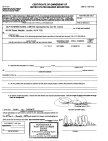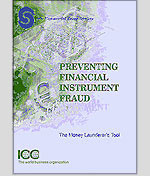
Education Associates, Inc.
A Non-Profit Corporation
|
Quatloos! > Investment Fraud > Treasury Scams & Forgeries > Exhibit: Treasury Securities Fraud Exhibit: TREASURY SECURITIES FRAUD Reprinted from: http://www.treasuryscams.gov/cc/ccphony2.htm Scams Involving Treasury SecuritiesScams Involving the Renting or Leasing of Treasury Securities The U.S. Treasury often hears about solicitations to "rent" or "lease" Treasury securities. Many of these solicitations have originated in the United Kingdom, Greece and South Africa. To date, the U.S. Treasury has yet to hear of a genuine renting or leasing arrangement. Usually, the securities offered either don't exist (for instance, the offer is for bearer securities in an amount that exceeds the amount that remains outstanding in bearer form for that particular CUSIP) or are not owned by the party making the offer. If you ask a leasing scam artist to produce the securities or otherwise prove ownership, he or she will be unable to do so and will proffer excuses such as "they are frozen at my bank;" "a wealthy philanthropist has assigned them to us to assign to others for infrastructure or humanitarian purposes in third world countries and wishes to remain anonymous;" and "bank secrecy laws of this country prevent such a verification." In addition, the scam artist will use one or more of the following tricks to try to con you:
Scam artists often misuse Public Debt forms to attempt to prove ownership or to make the scam seem "official." The two forms that are commonly misused are:
The U.S. Treasury only uses the PD F 1832 in limited cases to correct defective assignments of securities already in our possession. The U.S. Treasury also sometimes uses it for the assignment of a large number of securities or where there is an assignment by two or more geographically separated owners. In all cases the form is not valid unless the registered securities actually accompany the form. The U.S. Treasury uses the PD F 1071 to validate the ownership of bearer notes and bonds that are presented for redemption after they have become overdue. A bearer security becomes overdue after the lapse of between one and six months time from its face maturity date, depending on the original term of the security (e.g., three months for a three-year note).
Scams Involving the Blocking of Assigned Treasury Securities THE IMPORTANT THING TO REMEMBER IS THAT BOTH THE PD F 1832 AND THE PD F 1071 HAVE ABSOLUTELY NOTHING TO DO WITH BOOK-ENTRY BILLS, NOTES OR BONDS. UNLESS THERE ARE ACTUAL SECURITIES PHYSICALLY ATTACHED TO ONE OF THESE FORMS, THE FORM IS MEANINGLESS AND WORTHLESS.
The scam artists will also use a valid CUSIP number of a Treasury security that trades regularly in the market so a potential victim can get pricing information and confirm that the U.S. Treasury did issue the security. CUSIP is an acronym for the Committee on Uniform Securities Identification Procedures. Each security issue (stocks, corporate, municipal or Treasury securities) has a unique CUSIP number. The CUSIP number is public information and it identifies an entire issue of a security. It does not identify any particular security, nor does mere use of it indicate ownership.
The scam artists may claim that their fraudulent offering has been certified by an official body such as the U.S. Embassy in London or the International Chamber of Commerce. They may also claim that the U.S. Treasury has created a special issue to the United Nations to pass on to other companies that were willing to do humanitarian and infrastructure projects in developing countries. All of these claims are patently false. Scams Involving the Blocking of Assigned Treasury Securities The U.S. Treasury periodically receive requests to block off an amount of Treasury securities so the securities can be used to fund humanitarian or infrastructure projects in developing countries. This request is impossible for us to honor. The U.S. Treasury only sells securities at public auctions. Once sold, they are owned by the individual purchasers, not us. The U.S. Treasury can not block securities that they do not own. |
How to Protect Yourself from Investment Scams How Marketable Treasury Securities Really Work We do NOT spam. Various multi-level marketers & other criminals have recently sent out spam impersonating us, & having our return email address, so that people would complain about spam and cause us to be shut down (a/k/a "joe job"). These multi-level marketers and other criminals have engaged in this form of cyber-terrorism because our telling the truth about their fraudulent schemes was hurting their ability to sell to new victims. Fortunately, our ISP now recognizes that these fake spams are bogus and ignores them, and additionally we are duplicating this site on numerous other servers (including "hardened" servers as well as our own proprietary servers) so that we cannot be harmed by these multi-level marketers and other criminals. Death to Spammers! "Preventing Financial Instrument Fraud" -- prepared by the ICC Commercial Crime Services, the anti-crime arm of the International Chamber of Commerce. This unique reference guide uncovers the mysterious world of High Yield Investment Programs (HYIP) and Financial Products such as Letters of Credit, Bank Guarantees, CD's, Safe-Keeping Receipts and more as used by Fraudsters. By Jon Merrett and Paul Renner |
 |
© 2002- by Quatloosia Publishing LLC.. All rights reserved. No portion of this website may be reprinted in whole or in part without the express, written permission of Financial & Tax Fraud Associates, Inc. This site is http://www.quatloos.com. Legal issues should be faxed to (877) 698-0678. Our attorneys are Grobaty & Pitet LLP (http://grobatypitet.com) and Riser Adkisson LLP (http://risad.com).
 |
 |
 |
 |
| www.assetprotectionbook.com | www.farbook.com | www.eiabook.com | Lost Eye Book |
Website designed and maintained by John Barrick





